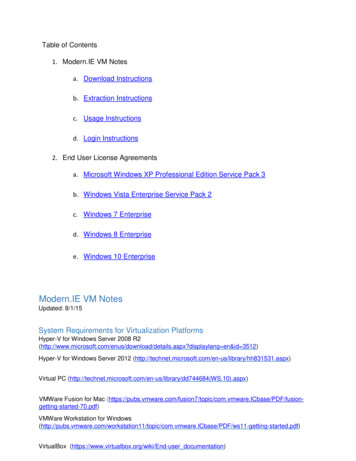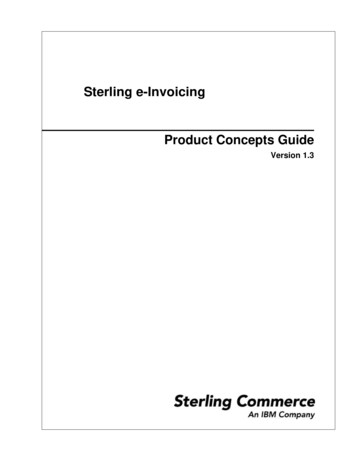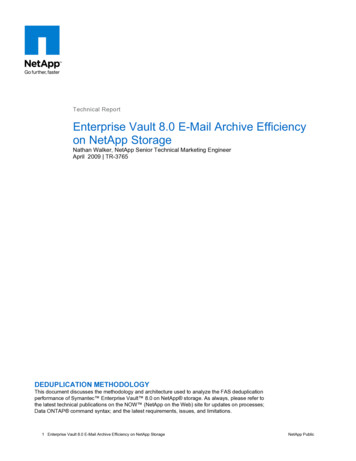
Transcription
IntroductiontoMachineLearningThirdEdition
Adaptive Computation and Machine LearningThomas Dietterich, EditorChristopher Bishop, David Heckerman, Michael Jordan, and MichaelKearns, Associate EditorsA complete list of books published in The Adaptive Computation andMachine Learning series appears at the back of this book.
IntroductiontoMachineLearningThirdEditionEthem AlpaydınThe MIT PressCambridge, MassachusettsLondon, England
2014 Massachusetts Institute of TechnologyAll rights reserved. No part of this book may be reproduced in any form by anyelectronic or mechanical means (including photocopying, recording, or information storage and retrieval) without permission in writing from the publisher.For information about special quantity discounts, please emailspecial sales@mitpress.mit.edu.Typeset in 10/13 Lucida Bright by the author using LATEX 2ε .Printed and bound in the United States of America.Library of Congress Cataloging-in-Publication InformationAlpaydin, Ethem.Introduction to machine learning / Ethem Alpaydin—3rd ed.p. cm.Includes bibliographical references and index.ISBN 978-0-262-02818-9 (hardcover : alk. paper)1. Machine learning. I. TitleQ325.5.A46 2014006.3’1—dc232014007214CIP10 9 8 7 6 5 4 3 2 1
Brief Contents1Introduction2Supervised Learning13Bayesian Decision Theory4Parametric Methods5Multivariate Methods6Dimensionality Reduction7Clustering8Nonparametric Methods9Decision Trees2149659311516118521310Linear Discrimination11Multilayer Perceptrons12Local Models23926731713Kernel Machines14Graphical Models15Hidden Markov Models16Bayesian Estimation17Combining Multiple Learners18Reinforcement Learning19Design and Analysis of Machine Learning ExperimentsA Probability593349387417445487517547
ContentsPrefacexviiNotationsxxi1 Introduction1.11.21.31.41.51.61What Is Machine Learning?1Examples of Machine Learning Applications1.2.1 Learning Associations41.2.2 Classification51.2.3 Regression91.2.4 Unsupervised Learning111.2.5 Reinforcement Learning13Notes14Relevant Resources17Exercises18References202 Supervised Learning2.12.22.32.42.52.62.72.82.9421Learning a Class from Examples21Vapnik-Chervonenkis Dimension27Probably Approximately Correct Learning29Noise30Learning Multiple Classes32Regression34Model Selection and Generalization37Dimensions of a Supervised Machine Learning AlgorithmNotes4241
ixContents5.11References1136 Dimensionality 136.146.15Introduction115Subset Selection116Principal Component Analysis120Feature Embedding127Factor Analysis130Singular Value Decomposition and Matrix FactorizationMultidimensional Scaling136Linear Discriminant Analysis140Canonical Correlation Analysis145Isomap148Locally Linear Embedding150Laplacian Eigenmaps153Notes155Exercises157References1587 61Introduction161Mixture Densities162k-Means Clustering163Expectation-Maximization Algorithm167Mixtures of Latent Variable Models172Supervised Learning after Clustering173Spectral Clustering175Hierarchical Clustering176Choosing the Number of Clusters178Notes179Exercises180References1828 Nonparametric Methods8.18.28.3115185Introduction185Nonparametric Density Estimation1868.2.1 Histogram Estimator1878.2.2 Kernel Estimator1888.2.3 k-Nearest Neighbor Estimator190Generalization to Multivariate Data192135
ic Classification193Condensed Nearest Neighbor194Distance-Based Classification196Outlier Detection199Nonparametric Regression: Smoothing Models2018.8.1 Running Mean Smoother2018.8.2 Kernel Smoother2038.8.3 Running Line Smoother204How to Choose the Smoothing Parameter204Notes205Exercises208References2109 Decision Univariate Trees2159.2.1 Classification Trees2169.2.2 Regression Trees220Pruning222Rule Extraction from Trees225Learning Rules from Data226Multivariate Trees230Notes232Exercises235References23710 Linear ntroduction239Generalizing the Linear Model241Geometry of the Linear Discriminant10.3.1 Two Classes24210.3.2 Multiple Classes244Pairwise Separation246Parametric Discrimination RevisitedGradient Descent248Logistic Discrimination25010.7.1 Two Classes25010.7.2 Multiple Classes254Discrimination by Regression257242247
xiContents10.910.1010.1110.12Learning to RankNotes263Exercises263References26626011 Multilayer 1.1 Understanding the Brain26811.1.2 Neural Networks as a Paradigm for ParallelProcessing269The Perceptron271Training a Perceptron274Learning Boolean Functions277Multilayer Perceptrons279MLP as a Universal Approximator281Backpropagation Algorithm28311.7.1 Nonlinear Regression28411.7.2 Two-Class Discrimination28611.7.3 Multiclass Discrimination28811.7.4 Multiple Hidden Layers290Training Procedures29011.8.1 Improving Convergence29011.8.2 Overtraining29111.8.3 Structuring the Network29211.8.4 Hints295Tuning the Network Size297Bayesian View of Learning300Dimensionality Reduction301Learning Time30411.12.1 Time Delay Neural Networks30411.12.2 Recurrent Networks305Deep Learning306Notes309Exercises311References31312 Local Models12.112.2267317Introduction317Competitive Learning318
xiiContents12.2.1 Online k-Means31812.2.2 Adaptive Resonance Theory32312.2.3 Self-Organizing Maps32412.3 Radial Basis Functions32612.4 Incorporating Rule-Based Knowledge33212.5 Normalized Basis Functions33312.6 Competitive Basis Functions33512.7 Learning Vector Quantization33812.8 The Mixture of Experts33812.8.1 Cooperative Experts34112.8.2 Competitive Experts34212.9 Hierarchical Mixture of Experts34212.10 Notes34312.11 Exercises34412.12 References34713 Kernel ptimal Separating Hyperplane351The Nonseparable Case: Soft Margin Hyperplaneν-SVM358Kernel Trick359Vectorial Kernels361Defining Kernels364Multiple Kernel Learning365Multiclass Kernel Machines367Kernel Machines for Regression368Kernel Machines for Ranking373One-Class Kernel Machines374Large Margin Nearest Neighbor Classifier377Kernel Dimensionality Reduction379Notes380Exercises382References38314 Graphical l Cases for Conditional IndependenceGenerative Models396389
xiiiContents14.414.5d-Separation399Belief Propagation39914.5.1 Chains40014.5.2 Trees40214.5.3 Polytrees40414.5.4 Junction Trees40614.6 Undirected Graphs: Markov Random Fields14.7 Learning the Structure of a Graphical Model14.8 Influence Diagrams41114.9 Notes41214.10 Exercises41314.11 References41515 Hidden Markov 1115.1215.1316.3417Introduction417Discrete Markov Processes418Hidden Markov Models421Three Basic Problems of HMMs423Evaluation Problem423Finding the State Sequence427Learning Model Parameters429Continuous Observations432The HMM as a Graphical Model433Model Selection in HMMs436Notes438Exercises440References44316 Bayesian Estimation16.116.2407410445Introduction445Bayesian Estimation of the Parameters of a DiscreteDistribution44916.2.1 K 2 States: Dirichlet Distribution44916.2.2 K 2 States: Beta Distribution450Bayesian Estimation of the Parameters of a GaussianDistribution45116.3.1 Univariate Case: Unknown Mean, KnownVariance451
16.1316.1416.1516.3.2 Univariate Case: Unknown Mean, UnknownVariance45316.3.3 Multivariate Case: Unknown Mean, UnknownCovariance455Bayesian Estimation of the Parameters of a Function45616.4.1 Regression45616.4.2 Regression with Prior on Noise Precision46016.4.3 The Use of Basis/Kernel Functions46116.4.4 Bayesian Classification463Choosing a Prior466Bayesian Model Comparison467Bayesian Estimation of a Mixture Model470Nonparametric Bayesian Modeling473Gaussian Processes474Dirichlet Processes and Chinese Restaurants478Latent Dirichlet Allocation480Beta Processes and Indian Buffets482Notes483Exercises484References48517 Combining Multiple 7.1117.1217.1317.14487Rationale487Generating Diverse Learners488Model Combination Schemes491Voting492Error-Correcting Output Codes496Bagging498Boosting499The Mixture of Experts Revisited502Stacked Generalization504Fine-Tuning an Ensemble50517.10.1 Choosing a Subset of the Ensemble17.10.2 Constructing erences513506
xvContents18 Reinforcement Learning51718.118.218.318.4Introduction517Single State Case: K-Armed Bandit519Elements of Reinforcement Learning520Model-Based Learning52318.4.1 Value Iteration52318.4.2 Policy Iteration52418.5 Temporal Difference Learning52518.5.1 Exploration Strategies52518.5.2 Deterministic Rewards and Actions52618.5.3 Nondeterministic Rewards and Actions52718.5.4 Eligibility Traces53018.6 Generalization53118.7 Partially Observable States53418.7.1 The Setting53418.7.2 Example: The Tiger Problem53618.8 Notes54118.9 Exercises54218.10 References54419 Design and Analysis of Machine Learning Factors, Response, and Strategy of ExperimentationResponse Surface Design553Randomization, Replication, and Blocking554Guidelines for Machine Learning Experiments555Cross-Validation and Resampling Methods55819.6.1 K-Fold Cross-Validation55919.6.2 5 2 Cross-Validation56019.6.3 Bootstrapping56119.7 Measuring Classifier Performance56119.8 Interval Estimation56419.9 Hypothesis Testing56819.10 Assessing a Classification Algorithm’s Performance19.10.1 Binomial Test57119.10.2 Approximate Normal Test57219.10.3 t Test57219.11 Comparing Two Classification Algorithms57319.11.1 McNemar’s Test573547550570
xviContents19.1219.1319.1419.1519.1619.1719.11.2 K-Fold Cross-Validated Paired t Test57319.11.3 5 2 cv Paired t Test57419.11.4 5 2 cv Paired F Test575Comparing Multiple Algorithms: Analysis of VarianceComparison over Multiple Datasets58019.13.1 Comparing Two Algorithms58119.13.2 Multiple Algorithms583Multivariate Tests58419.14.1 Comparing Two Algorithms58519.14.2 Comparing Multiple Algorithms586Notes587Exercises588References590A ProbabilityA.1A.2A.3A.4Index593Elements of Probability593A.1.1 Axioms of Probability594A.1.2 Conditional Probability594Random Variables595A.2.1 Probability Distribution and Density FunctionsA.2.2 Joint Distribution and Density Functions596A.2.3 Conditional Distributions596A.2.4 Bayes’ Rule597A.2.5 Expectation597A.2.6 Variance598A.2.7 Weak Law of Large Numbers599Special Random Variables599A.3.1 Bernoulli Distribution599A.3.2 Binomial Distribution600A.3.3 Multinomial Distribution600A.3.4 Uniform Distribution600A.3.5 Normal (Gaussian) Distribution601A.3.6 Chi-Square Distribution602A.3.7 t Distribution603A.3.8 F Distribution603References603605576595
PrefaceMachine learning must be one of the fastest growing fields in computerscience. It is not only that the data is continuously getting “bigger,” butalso the theory to process it and turn it into knowledge. In various fieldsof science, from astronomy to biology, but also in everyday life, as digital technology increasingly infiltrates our daily existence, as our digitalfootprint deepens, more data is continuously generated and collected.Whether scientific or personal, data that just lies dormant passively isnot of any use, and smart people have been finding ever new ways tomake use of that data and turn it into a useful product or service. In thistransformation, machine learning plays a larger and larger role.This data evolution has been continuing even stronger since the second edition appeared in 2010. Every year, datasets are getting larger. Notonly has the number of observations grown, but the number of observedattributes has also increased significantly. There is more structure tothe data: It is not just numbers and character strings any more but images, video, audio, documents, web pages, click logs, graphs, and so on.More and more, the data moves away from the parametric assumptionswe used to make—for example, normality. Frequently, the data is dynamic and so there is a time dimension. Sometimes, our observationsare multi-view—for the same object or event, we have multiple sourcesof information from different sensors and modalities.Our belief is that behind all this seemingly complex and voluminousdata, there lies a simple explanation. That although the data is big, it canbe explained in terms of a relatively simple model with a small number ofhidden factors and their interaction. Think about millions of customerswho each day buy thousands of products online or from their local supermarket. This implies a very large database of transactions, but there is a
xviiiPrefacepattern to this data. People do not shop at random. A person throwinga party buys a certain subset of products, and a person who has a babyat home buys a different subset; there are hidden factors that explaincustomer behavior.This is one of the areas where significant research has been done inrecent years—namely, to infer this hidden model from observed data.Most of the revisions in this new edition are related to these advances.Chapter 6 contains new sections on feature embedding, singular valuedecomposition and matrix factorization, canonical correlation analysis,and Laplacian eigenmaps.There are new sections on distance estimation in chapter 8 and on kernel machines in chapter 13: Dimensionality reduction, feature extraction,and distance estimation are three names for the same devil—the idealdistance measure is defined in the space of the ideal hidden features,and they are fewer in number than the values we observe.Chapter 16 is rewritten and significantly extended to cover such generative models. We discuss the Bayesian approach for all major machinelearning models, namely, classification, regression, mixture models, anddimensionality reduction. Nonparametric Bayesian modeling, which hasbecome increasingly popular during these last few years, is especially interesting because it allows us to adjust the complexity of the model tothe complexity of data.New sections have been added here and there, mostly to highlight different recent applications of the same or very similar methods. There is anew section on outlier detection in chapter 8. Two new sections in chapters 10 and 13 discuss ranking for linear models and kernel machines,respectively. Having added Laplacian eigenmaps to chapter 6, I also include a new section on spectral clustering in chapter 7. Given the recentresurgence of deep neural networks, it became necessary to include anew section on deep learning in chapter 11. Chapter 19 contains a newsection on multivariate tests for comparison of methods.Since the first edition, I have received many requests for the solutionsto exercises from readers who use the book for self-study. In this newedition, I have included the solutions to some of the more didactic exercises. Sometimes they are complete solutions, and sometimes they givejust a hint or offer only one of several possible solutions.I would like to thank all the instructors and students who have used theprevious two editions, as well as their translations into German, Chinese,and Turkish, and their reprints in India. I am always grateful to those
Prefacexixwho send me words of appreciation, criticism, or errata, or who providefeedback in any other way. Please keep them coming. My email addressis alpaydin@boun.edu.tr. The book’s web site ishttp://www.cmpe.boun.edu.tr/ ethem/i2ml3e.It has been a pleasure to work with the MIT Press again on this third edition, and I thank Marie Lufkin Lee, Marc Lowenthal, and Kathleen Carusofor all their help and support.
NotationsxScalar valuexVectorXxMatrixTTransposeX 1InverseXRandom variableP (X)Probability mass function when X is discretep(X)Probability density function when X is continuousP (X Y )Conditional probability of X given YE[X]Expected value of the random variable XVar(X)Variance of XCov(X, Y )Covariance of X and YCorr(X, Y )Correlation of X and YμMeanσ2VarianceΣCovariance matrixmEstimator to the means2SEstimator to the varianceEstimator to the covariance matrix
xxiiNotationsN (μ, σ 2 )Univariate normal distribution with mean μ and variance σ 2ZUnit normal distribution: N (0, 1)Nd (μ, Σ)d-variate normal distribution with mean vector μ andcovariance matrix ΣxInputdNumber of inputs (input dimensionality)yOutputrRequired outputKNumber of outputs (classes)NNumber of training instanceszHidden value, intrinsic dimension, latent factorkNumber of hidden dimensions, latent factorsCiClass iXTraining sample{xt }Nt 1Set of x with index t ranging from 1 to N{x , r }tSet of ordered pairs of input and desired output withindex tg(x θ)Function of x defined up to a set of parameters θttarg maxθ g(x θ) The argument θ for which g has its maximum valuearg minθ g(x θ) The argument θ for which g has its minimum valueE(θ X)Error function with parameters θ on the sample Xl(θ X)Likelihood of parameters θ on the sample XL(θ X)Log likelihood of parameters θ on the sample X1(c)1 if c is true, 0 otherwise#{c}Number of elements for which c is trueδijKronecker delta: 1 if i j, 0 otherwise
11.1IntroductionWhat Is Machine Learning?T h i s i s the age of “big data.” Once upon a time, only companies haddata. There used to be computer centers where that data was stored andprocessed. First with the arrival of personal computers and later with thewidespread use of wireless communications, we all became producers ofdata. Every time we buy a product, every time we rent a movie, visit aweb page, write a blog, or post on the social media, even when we justwalk or drive around, we are generating data.Each of us is not only a generator but also a consumer of data. We wantto have products and services specialized for us. We want our needs tobe understood and interests to be predicted.Think, for example, of a supermarket chain that is selling thousandsof goods to millions of customers either at hundreds of brick-and-mortarstores all over a country or through a virtual store over the web. The details of each transaction are stored: date, customer id, goods bought andtheir amount, total money spent, and so forth. This typically amounts toa lot of data every day. What the supermarket chain wants is to be able topredict which customer is likely to buy which product, to maximize salesand profit. Similarly each customer wants to find the set of products bestmatching his/her needs.This task is not evident. We do not know exactly which people arelikely to buy this ice cream flavor or the next book of this author, see thisnew movie, visit this city, or click this link. Customer behavior changesin time and by geographic location. But we know that it is not completelyrandom. People do not go to supermarkets and buy things at random.When they buy beer, they buy chips; they buy ice cream in summer and
21Introductionspices for Glühwein in winter. There are certain patterns in the data.To solve a problem on a computer, we need an algorithm. An algorithmis a sequence of instructions that should be carried out to transform theinput to output. For example, one can devise an algorithm for sorting.The input is a set of numbers and the output is their ordered list. For thesame task, there may be various algorithms and we may be interested infinding the most efficient one, requiring the least number of instructionsor memory or both.For some tasks, however, we do not have an algorithm. Predicting customer behavior is one; another is to tell spam emails from legitimateones. We know what the input is: an email document that in the simplest case is a file of characters. We know what the output should be: ayes/no output indicating whether the message is spam or not. But we donot know how to transform the input to the output. What is consideredspam changes in time and from individual to individual.What we lack in knowledge, we make up for in data. We can easilycompile thousands of example messages, some of which we know to bespam and some of which are not, and what we want is to “learn” whatconstitutes spam from them. In other words, we would like the computer(machine) to extract automatically the algorithm for this task. There is noneed to learn to sort numbers since we already have algorithms for that,but there are many applications for which we do not have an algorithmbut have lots of data.We may not be able to identify the process completely, but we believewe can construct a good and useful approximation. That approximationmay not explain everything, but may still be able to account for some partof the data. We believe that though identifying the complete process maynot be possible, we can still detect certain patterns or regularities. Thisis the niche of machine learning. Such patterns may help us understandthe process, or we can use those patterns to make predictions: Assumingthat the future, at least the near future, will not be much different fromthe past when the sample data was collected, the future predictions canalso be expected to be right.Application of machine learning methods to large databases is calleddata mining. The analogy is that a large volume of earth and raw material is extracted from a mine, which when processed leads to a smallamount of very precious material; similarly, in data mining, a large volume of data is processed to construct a simple model with valuable use,for example, having high predictive accuracy. Its application areas are
1.1What Is Machine Learning?3abundant: In addition to retail, in finance banks analyze their past datato build models to use in credit applications, fraud detection, and thestock market. In manufacturing, learning models are used for optimization, control, and troubleshooting. In medicine, learning programs areused for medical diagnosis. In telecommunications, call patterns are analyzed for network optimization and maximizing the quality of service.In science, large amounts of data in physics, astronomy, and biology canonly be analyzed fast enough by computers. The World Wide Web is huge;it is constantly growing, and searching for relevant information cannot bedone manually.But machine learning is not just a database problem; it is also a partof artificial intelligence. To be intelligent, a system that is in a changingenvironment should have the ability to learn. If the system can learn andadapt to such changes, the system designer need not foresee and providesolutions for all possible situations.Machine learning also helps us find solutions to many problems in vision, speech recognition, and robotics. Let us take the example of recognizing faces: This is a task we do effortlessly; every day we recognizefamily members and friends by looking at their faces or from their photographs, despite differences in pose, lighting, hair style, and so forth.But we do it unconsciously and are unable to explain how we do it. Because we are not able to explain our expertise, we cannot write the computer program. At the same time, we know that a face image is not just arandom collection of pixels; a face has structure. It is symmetric. Thereare the eyes, the nose, the mouth, located in certain places on the face.Each person’s face is a pattern composed of a particular combinationof these. By analyzing sample face images of a person, a learning program captures the pattern specific to that person and then recognizes bychecking for this pattern in a given image. This is one example of patternrecognition.Machine learning is programming computers to optimize a performancecriterion using example data or past experience. We have a model definedup to some parameters, and learning is the execution of a computer program to optimize the parameters of the model using the training data orpast experience. The model may be predictive to make predictions in thefuture, or descriptive to gain knowledge from data, or both.Machine learning uses the theory of statistics in building mathematicalmodels, because the core task is making inference from a sample. Therole of computer science is twofold: First, in training, we need efficient
41Introductionalgorithms to solve the optimization problem, as well as to store and process the massive amount of data we generally have. Second, once a modelis learned, its representation and algorithmic solution for inference needsto be efficient as well. In certain applications, the efficiency of the learning or inference algorithm, namely, its space and time complexity, maybe as important as its predictive accuracy.Let us now discuss some example applications in more detail to gainmore insight into the types and uses of machine learning.1.21.2.1association ruleExamples of Machine Learning ApplicationsLearning AssociationsIn the case of retail—for example, a supermarket chain—one applicationof machine learning is basket analysis, which is finding associations between products bought by customers: If people who buy X typically alsobuy Y , and if there is a customer who buys X and does not buy Y , heor she is a potential Y customer. Once we find such customers, we cantarget them for cross-selling.In finding an association rule, we are interested in learning a conditionalprobability of the form P (Y X) where Y is the product we would like tocondition on X, which is the product or the set of products which weknow that the customer has already purchased.Let us say, going over our data, we calculate that P (chips beer) 0.7.Then, we can define the rule:70 percent of customers who buy beer also buy chips.We may want to make a distinction among customers and toward this,estimate P (Y X, D) where D is the set of customer attributes, for example, gender, age, marital status, and so on, assuming that we have accessto this information. If this is a bookseller instead of a supermarket, products can be books or authors. In the case of a web portal, items correspond to links to web pages, and we can estimate the links a user is likelyto click and use this information to download such pages in advance forfaster access.
1.21.2.2classificationExamples of Machine Learning Applications5ClassificationA credit is an amount of money loaned by a financial institution, forexample, a bank, to be paid back with interest, generally in installments.It is important for the bank to be able to predict in advance the riskassociated with a loan, which is the probability that the customer willdefault and not pay the whole amount back. This is both to make surethat the bank will make a profit and also to not inconvenience a customerwith a loan over his or her financial capacity.In credit scoring (Hand 1998), the bank calculates the risk given theamount of credit and the information about the customer. The information about the customer includes data we have access to and is relevant incalculating his or her financial capacity—namely, income, savings, collaterals, profession, age, past financial history, and so forth. The bank hasa record of past loans containing such customer data and whether theloan was paid back or not. From this data of particular applications, theaim is to infer a general rule coding the association between a customer’sattributes and his risk. That is, the machine learning system fits a modelto the past data to be able to calculate the risk for a new application andthen decides to accept or refuse it accordingly.This is an example of a classification problem where there are twoclasses: low-risk and high-risk customers. The information about a customer makes up the input to the classifier whose task is to assign theinput to one of the two classes.After training with the past data, a classification rule learned may beof the formIF income θ1 AND savings θ2 THEN low-risk ELSE high-riskdiscriminantpredictionfor suitable values of θ1 and θ2 (see figure 1.1). This is an example ofa discriminant; it is a function that separates the examples of differentclasses.Having a rule like this, the main application is prediction: Once we havea rule that fits the past data, if the future is similar to the past, then wecan make correct predictions for novel instances. Given a new applicationwith a certain income and savings, we can easily decide whether it is lowrisk or high-risk.In some cases, instead of making a 0/1 (low-risk/high-risk) type decision, we may want to calculate a probability, namely, P (Y X), whereX are the customer attributes and Y is 0 or 1 respectively for low-risk
Figure 1.1 Example of a training dataset where each circle corresponds to onedata instance with input values in the corresponding axes and its sign indicatesthe class. For simplicity, only two customer attributes, income and savings,are taken as input and the two classes are low-risk (‘ ’) and high-risk (‘ ’). Anexample discriminant that separates the two types of examples is also shown.patternrecognitionand high-risk. From this perspective, we can see classification as learning an association from X to Y . Then for a given X x, if we haveP (Y 1 X x) 0.8, we say that the customer has an 80 percent probability of being high-risk, or equivalently a 20 percent probability of beinglow-risk. We then decide whether to accept or refuse the loan dependingon the possible gain and loss.There are many applications of machine learning in pattern recognition.One is optical character recognition, which is recognizing character codesfrom their images. This is an example where there are multiple classes,as many as there are characters we would like to recognize. Especially interesting is the case when the characters are handwritten—for example,to read zip codes on envelopes or amounts on checks. People have different handwriting styles; characters may be written small or large, slanted,with a pen or pencil, and there are many possible images corresponding
1.2Examples of Mach
1.1 What Is Machine Learning? 1 1.2 Examples of Machine Learning Applications 4 1.2.1 Learning Associations 4 1.2.2 Classification 5 1.2.3 Regression 9 1.2.4 Unsupervised Learning 11 1.2.5 Reinforcement Learning 13 1.3 Notes 14 1.4 Relevant Resources 17 1.5 Exercises 18 1.6 References 20 2 Supervised Learning 21 2.1 Learning a Class from .

![March 3rd, 2017 [Manage Archive in Microsoft Outlook 2016]](/img/34/archive-outlook-2016.jpg)








